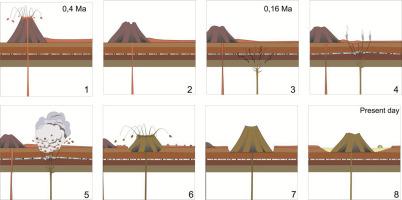Corina Risso, Prezzi, C., Orgeira, M. J., Nullo, F., Margonari, L. y Németh, K.
2 015
Journal of South American Earth Sciences, vol. 63, pag. 360-374. doi 10.1016/j.jsames.2015.08.007
Here we describe the unusual genesis of steptoes in Las Bombas volcano- Llancanelo Volcanic Field (LVF) (Pliocene e Quaternary), Mendoza, Argentina. Typically, a steptoe forms when a lava flow envelops a hill, creating a well-defined stratigraphic relationship between the older hill and the younger lava flow. In the Llancanelo Volcanic Field, we find steptoes formed with an apparent normal stratigraphic relationship but an inverse age-relationship. Eroded remnants of scoria cones occur in “circular depressions” in the lava field. To express the inverse age-relationship between flow fields and depression filled cones here we define this landforms as inverse steptoes. Magnetometric analysis supports this inverse age relationship, indicating reverse dipolar magnetic anomalies in the lava field and normal dipolar magnetization in the scoria cones (e.g. La Bombas). Negative Bouguer anomalies calculated for Las Bombas further support the interpretation that the scoria cones formed by secondary fracturing on already solidified basaltic lava flows. Advanced erosion and mass movements in the inner edge of the depressions created a perfectly excavated circular depression enhancing the “crater-like” architecture of the preserved landforms.
Given the unusual genesis of the steptoes in LVF, we prefer the term inverse steptoe for these landforms. The term steptoe is a geomorphological name that has genetic implications, indicating an older hill and a younger lava flow. Here the relationship is reversed.
Given the unusual genesis of the steptoes in LVF, we prefer the term inverse steptoe for these landforms. The term steptoe is a geomorphological name that has genetic implications, indicating an older hill and a younger lava flow. Here the relationship is reversed.

